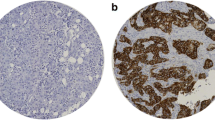Abstract
To evaluate the expression levels of serine/glycine metabolism-related proteins (PHGDH, PSAT, PSPH, SHMT, and GLDC) in six different subtypes of triple negative breast cancer (TNBC) patients and gain insight into their implications. Formalin-fixed, paraffin-embedded tissues from 129 TNBC patients were assembled into tissue microarrays. Immunohistochemical staining was performed for serine/glycine metabolism-related proteins (PHGDH, PSAT, PSPH, SHMT, and GLDC) and surrogate immunohistochemical markers (CK5/6, EGFR, claudin 3, claudin 4, claudin 7, E-cadherin, STAT1, interleukin-8 [IL-8], AR, and GGT-1) for identifying the molecular subtype of TNBC. TNBC subtype classifications included the following: basal-like (CK5/6-positive and/or EGFR-positive), molecular apocrine (AR-positive and/or GGT-1-positive), claudin-low (claudin 3-, claudin 4-, claudin 7-negative and/or E-cadherin-negative), immune-related (IL-8-negative and stromal STAT1-positive), mixed (features from two or more of the four subtypes), and null (no features from any of the four subtypes). Tissues from basal marker-positive patients showed increased expression levels of tumoral PHGDH compared with those from basal marker-negative patients (p = 0.029); lack of stromal SHMT1 expression was significantly correlated with T stage (p = 0.016). Multivariate Cox analysis revealed that a lack of stromal SHMT1 expression was an independent prognostic factor for predicting a shorter disease-free survival period (hazard ratio 4.002, 95 % confidence interval [CI] 1.077–14.83, p = 0.038); furthermore, a lack of tumoral PHGDH expression was predictive of a shorter overall survival rate (hazard ratio 3.053, 95 % CI 1.002–9.305, p = 0.050). In conclusion, the most abundantly expressed serine/glycine metabolism-related protein in basal-like TNBC tissues was tumoral PHGDH, and expression levels of stromal SHMT1 and tumoral PHGDH were inversely correlated with clinical prognostic factors. Also, this study is the first to assess serine/glycine relationships at the protein level in regards to clinical outcomes.



Similar content being viewed by others
References
Warburg O. On the origin of cancer cells. Science. 1956;123:309–14.
Jain M, Nilsson R, Sharma S, Madhusudhan N, Kitami T, Souza AL, et al. Metabolite profiling identifies a key role for glycine in rapid cancer cell proliferation. Science. 2012;336:1040–4.
Mullarky E, Mattaini KR, Vander Heiden MG, Cantley LC, Locasale JW. PHGDH amplification and altered glucose metabolism in human melanoma. Pigment Cell Melanoma Res. 2011;24:1112–5.
Possemato R, Marks KM, Shaul YD, Pacold ME, Kim D, Birsoy K, et al. Functional genomics reveal that the serine synthesis pathway is essential in breast cancer. Nature. 2011;476:346–50.
Zhang WC, Shyh-Chang N, Yang H, Rai A, Umashankar S, Ma S, et al. Glycine decarboxylase activity drives non-small cell lung cancer tumor-initiating cells and tumorigenesis. Cell. 2012;148:259–72.
Dent R, Trudeau M, Pritchard KI, Hanna WM, Kahn HK, Sawka CA, et al. Triple-negative breast cancer: clinical features and patterns of recurrence. Clin Cancer Res. 2007;13:4429–34.
Perou CM. Molecular stratification of triple-negative breast cancers. Oncologist. 2011;16 Suppl 1:61–70.
Pinheiro C, Sousa B, Albergaria A, Paredes J, Dufloth R, Vieira D, et al. GLUT1 and CAIX expression profiles in breast cancer correlate with adverse prognostic factors and MCT1 overexpression. Histol Histopathol. 2011;26:1279–86.
Choi J, Jung WH, Koo JS. Metabolism-related proteins are differentially expressed according to the molecular subtype of invasive breast cancer defined by surrogate immunohistochemistry. Pathobiology. 2013;80:41–52.
Hammond ME, Hayes DF, Dowsett M, Allred DC, Hagerty KL, Badve S, et al. American Society of Clinical Oncology/College Of American Pathologists guideline recommendations for immunohistochemical testing of estrogen and progesterone receptors in breast cancer. J Clin Oncol. 2010;28:2784–95.
Wolff AC, Hammond ME, Schwartz JN, Hagerty KL, Allred DC, Cote RJ, et al. American Society of Clinical Oncology/College of American Pathologists guideline recommendations for human epidermal growth factor receptor 2 testing in breast cancer. J Clin Oncol. 2007;25:118–45.
Elston CW, Ellis IO. Pathological prognostic factors in breast cancerI. The value of histological grade in breast cancer: experience from a large study with long-term follow-up. Histopathology. 1991;19:403–10.
Won KY, Kim GY, Kim YW, Song JY, Lim SJ. Clinicopathologic correlation of beclin-1 and bcl-2 expression in human breast cancer. Hum Pathol. 2010;41:107–12.
Bonuccelli G, Tsirigos A, Whitaker-Menezes D, Pavlides S, Pestell RG, Chiavarina B, et al. Ketones and lactate "fuel" tumor growth and metastasis: evidence that epithelial cancer cells use oxidative mitochondrial metabolism. Cell Cycle. 2010;9:3506–14.
Martinez-Outschoorn UE, Balliet RM, Rivadeneira DB, Chiavarina B, Pavlides S, Wang C, et al. Oxidative stress in cancer associated fibroblasts drives tumor-stroma co-evolution: a new paradigm for understanding tumor metabolism, the field effect and genomic instability in cancer cells. Cell Cycle. 2010;9:3256–76.
Pavlides S, Tsirigos A, Vera I, Flomenberg N, Frank PG, Casimiro MC, et al. Loss of stromal caveolin-1 leads to oxidative stress, mimics hypoxia and drives inflammation in the tumor microenvironment, conferring the "reverse Warburg effect": a transcriptional informatics analysis with validation. Cell Cycle. 2010;9:2201–19.
Pavlides S, Whitaker-Menezes D, Castello-Cros R, Flomenberg N, Witkiewicz AK, Frank PG, et al. The reverse Warburg effect: aerobic glycolysis in cancer associated fibroblasts and the tumor stroma. Cell Cycle. 2009;8:3984–4001.
Stackhouse BL, Williams H, Berry P, Russell G, Thompson P, Winter JL, et al. Measurement of glut-1 expression using tissue microarrays to determine a race specific prognostic marker for breast cancer. Breast Cancer Res Treat. 2005;93:247–53.
Younes M, Brown RW, Mody DR, Fernandez L, Laucirica R. GLUT1 expression in human breast carcinoma: correlation with known prognostic markers. Anticancer Res. 1995;15:2895–8.
Acknowledgements
This research was supported by the Basic Science Research Program through the National Research Foundation of Korea (NRF) funded by the Ministry of Education, Science and Technology (2012R1A1A1002886). This study was supported by a faculty research grant from Yonsei University College of Medicine for 2013 (6-2013-0146).
Conflicts of interest
No potential conflicts of interest were disclosed.
Author information
Authors and Affiliations
Corresponding author
Rights and permissions
About this article
Cite this article
Noh, S., Kim, D.H., Jung, W.H. et al. Expression levels of serine/glycine metabolism-related proteins in triple negative breast cancer tissues. Tumor Biol. 35, 4457–4468 (2014). https://doi.org/10.1007/s13277-013-1588-z
Received:
Accepted:
Published:
Issue Date:
DOI: https://doi.org/10.1007/s13277-013-1588-z




